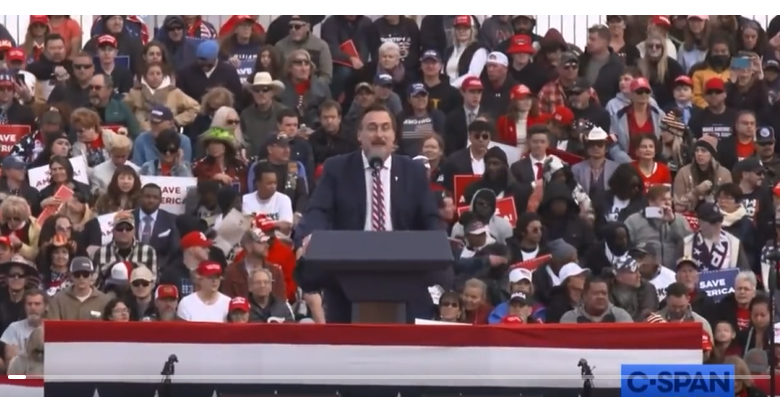“I know not with what weapons World War III will be fought but World War IV will be fought with sticks and stones.” — Albert Einstein
The MAGA election fraud festival is going into high gear this afternoon. As written here earlier today, the sole purpose of this gathering is to elevate the Big Lie as the central — and so far only — plank of Donald Trump’s 2024 election campaign. A collateral purpose is to use the Big Lie to endorse a whole slate of MAGA candidates.
One by one they are genuflecting to Trump in Florence, Arizona today. Here’s what that looks like. I think this is Kelli Ward.
The rally starts with talk of overwhelming “cheating algorithms” and a demand to get rid of Dominion and drop boxes pic.twitter.com/5BQIzGyKGM
— Acyn (@Acyn) January 15, 2022
Look out, that’s how you get joined in the lawsuit.
And that brings us to Mike Lindell.
Lindell: We all know what happened and it’s all going to get corrected… I will promise you this, there’s not going to be any election done with machines or computers done in 2022 pic.twitter.com/64zFGyfdbL
— Acyn (@Acyn) January 15, 2022
Alright, class, time for a pop quiz. What does Lindell MEAN when he says “there will be no machines or computers in 2022?”
- He’s going to unveil the new Lindell voting technology and we’re supposed to buy that? (Seriously, he’s got one. See the tweet below.)
- The MAGAs are going to destroy the world, so that we’re operating on a sticks and stones WWIV basis, as Einstein predicted?
- Lindell has figured out a way to destroy the Internet, figuring if he can’t rule it, nobody can, ergo, that’s the end of that “machine” and the downfall of world wide commerce?
- You’re going to be in prison with the rest of us 300 million Americas, so nobody will be around to hold an election, except some 8-year-olds and they’re too busy playing with the ducks. So what do you care?
Behold: from the PZ Archives of Wingnuttia, Mike Lindell talking about his voting system.
Oh God. Mike Lindell is now saying he has assembled teams of people to lobby County Commissions around the country to replace their voting machines with a new system he has come up with. Don’t think some of them won’t do it either. pic.twitter.com/oC70hBJg3U
— Ron Filipkowski (@RonFilipkowski) January 5, 2022
Go back and read my piece on MyPilfer, the Lindell alternative to voting machines.
And then Lindell takes his shot at Fox *News*
Lindell: This brings up the biggest problem we face. It’s not the fake news media… It’s the conservative media. The ones that don’t talk. One of them rhymes with Fox. Disgusting! They’re disgusting! pic.twitter.com/Oo1UlLwIHg
— Acyn (@Acyn) January 16, 2022
Rhymes with Fox? We don’t know what he’s raving about either. If he had said, “Rhymes with cocks” that would have been witty.
Look, sir. Look, sir.
Mr Knox, sir.
Let's do tricks with
bricks and blocks, sir.
Lets do tricks with
chicks and clocks, sir— Kevwhatev ??? (@kevwrex) January 16, 2022
And then there’s Wendy Rogers. Ridiculous as she is, she broke fundraising records for coming up with $2.5 million in donations last year, most of them small dollar and from out of state. The Big Lie is big money.
The audience is being warmed up for the ascension of the Great Political Pumpkin. The sun has set in Arizona and it’s a lovely 63 degrees without a cloud in the sky. Our coverage of mass psychosis in the southwest continues.





















It’s too late for Lindell to get his machines in, anywhere with enough votes to matter. They’d have to be tested and certified first, and since we don’t yet have evidence they even exist…not gonna happen.
Has anyone (MSM) done any research about his Frank enterprises? Is there a grift going on there? That’s the only thing that makes any sense to me. Nobody, in their right mind. spends what he says he has spent on a losing cause. Apparently he doesn’t have any family that cares enough to do an intervention or apply for a conservatorship
Is there grift going on? Does the sun rise in the east?
I really do hope that someone is working on those 74 million strait jackets and padded cells that we so desperately need!
I didn’t turn 18 until shortly before the 1976 Presidential election. Therefore the very first person I (proudly) voted for was Jimmy Carter. Noteworthy as that is, I’m from a town that at the time had a little over 10k people. It was also the County Seat. My ballot, as were all the ones used in my hometown were old-fashioned paper ballots. A bit large and unwieldy perhaps but we marked them with a pen, folded them up and put them in a locked ballot box.
At each precinct when the polls closed the election workers tallied up the votes for each race, right there amongst themselves with official representatives from each major Party witnessing. Once counted the results were entered on an official tally sheet and signed off on and the whole kit and kaboodle was locked up and driven over to the courthouse where the County Clerk was set up to record the precinct’s results on a big chalkboard in front of any news outlets covering things or members of the public who wished to be there. Once the results were tallied they were called into the Secratary of State’s office in Springfield which maintained open lines with every county throughout the night. The ballots were then locked up in boxes and the boxes had those special seals placed on them and that was that.
It was an unhackable system and frankly I’d like to see us go back to it. In both 2000 and since we’ve had elections where the result wasn’t known by midnight (eastern time) or say one in the morning. And in fact for much longer. Somehow we all survived. (I’m being snarky) So we might not know for sure until the sun comes up. BFD. We got along just fine that way before the TV age and as I’ve just said we’ve been okay even in the age of instant gratification/news.
As for the ballot counting, I don’t think there should be poll watchers present, either in the room on or on the premises. At least other than each Party’s designated monitor. Instead the process can be livestreamed with sound, with multiple camera angles.
That’s my opinion and I’m sticking to it.
Yeah, but in 1976, the US population was roughly 218 million and a little over 81 million people in total voted in the presidential election. In 2020, the population stood around 330 million (a 51% increase) and more than 158 million people in total voted in the election (a 95% increase); hell, Joe Biden alone got almost as many votes in 2020 as were cast for ALL the candidates running in 1976.
Frankly, there is NO problem with the current system. It’s only been because of Trump’s insecurities that there’s been any suggestion that there are “problems” with voting. Trump’s ego simply would not allow for the idea that he couldn’t win and so the GOP has been running around like a bunch of headless chickens screaming about “needing to secure our elections” (without explaining how so many of THEM could win their races if there were “irregularities” in voting) solely to help soothe Trump’s overbloated ego.
But, the system COULD be improved such as allowing voters to have physical copies of their accepted ballots to be retained for 2-4 weeks in case there is some sort of irregularity (someone watching the results learn that his precinct show absolutely no votes for a particular candidate–one the person had actually voted for and has a copy of his ballot showing that the candidate did have at least one vote). Or have ballots that have detachable copies (sort of like the old-fashioned credit card receipts; though this would be a little problematic when a ballot has material on both sides but, maybe just have longer ballots or have two or more separate ballots as necessary) and the voter pulls off his copy when he puts in the machine.
There is a problem in some jurisdictions that have electronic voting machines that do not produce a paper trail. I’m all for paper ballots. Whether you hand count or run them thru a counting machine, you always have the actual ballot to refer to in case of audit.
I find it odd that the cons are often times copying the left only in a perverted form sometimes decades later. Re: the RW’s use of Saul Alinsky’s tactics and now complaints about the electoral system. At the turn of the century, activist Bev Harris and her organization, Black Box Voting, researched and did field work PROVING there was widespread fraud in computer voting machines (aptly named “black boxes”). With unusual speed America moved from black boxes to paper ballots.
Bev wasn’t the first to come up with that idea, “Both optical scan systems which interpret paper ballots and Direct Recording Electronic (DRE) systems can be black box systems; in fact, mechanical voting machines can also be seen as black-box systems, since only the technicians who set up the machines have access to the linkages between the voting levers on the face of the machine and the vote recording counters inside. Rhode Island supreme court justice Horatio Rogers, in an 1897 dissenting opinion, wrote of one early mechanical voting machine that
… a voter on this voting machine has no knowledge, through his senses that he has accomplished a result. The most that can be said is, if the machine worked as intended, then he has made his holes and voted. It does not seem to me that this is enough.” (Wikipedia)
You’re not wrong. It is “unhackable”. Is it free from potential fraudulent acts? Well, no. Of course it isn’t.
We went to digital/scanned ballots because we are a nation of over 350 million people. Granted, that is not the size of our voting population but if we were hand counting ballots from the past election we’d likely still not have a result. 10k is an extremely small number compared to over 150 million.
You’re correct about 10k not being 150 million but if you’re as old as me then you know back then (1976) that’s how it was done in most places. Punch card voting was introduced in my hometown in 1980, but in 1976 most places couldn’t afford the machines (which themselves were huge/bulky) and software. Some places like NYC with their famous mechanical machines used non-paper ballots but again, computer time itself back in the 60s and 70s was insanely expensive. Software engineers would work for weeks to shave a half, or even quarter second of run-time of the execution of a program back then. The best talent back then were in the hard sciences working on that type of thing. The banking/financial industry hired people of course but didn’t pay the insane salaries we hear about nowdays, which is why they found themseves with the clunky COBOL (Common Business Oriented Language) which was nowhere near as efficient as FORTRAN which was the basic language of scientific pursuits. However, by the mid 70s it was clear that the computers were in fact going to become more cost friendly and the shift was underway to developing stuff that could utilize machines that were faster and smaller – instead of taking up an entire large room engineers knew a mainframe machine with what in the 1960s would have been unimaginable memory and speed (don’t laugh, but the thought of 124k by 1980 was by most considered an absurd dream for a machine that would fit on a desktop. Or even in a large copy machine) but the point of my original comment is that even with computers, we still wait well into the night (or longer) in many places to get results even with electronically counted ballots.
The answer is the one thing the GOP does NOT want. Lots of precincts with a reasonable number of voters to tend to. Oh, in their own places that’s how it is, and folks seldom wait more than fifteen or twenty minutes to vote from the time they get in line and usually not that long. Just like my ole hometown (which wasn’t ruby red GOP back then) back in the day. Having lots of precincts with manageable numbers of voters would mean non-conservatives can vote as easily as the people the GOP wants to get to vote. That would hurt them and badly. But it would also mean that whether the type of paper ballot I used in my first general election or a ballot that can be scanned to confirm the tallies during post election canvassing if not that very evening) after an old fashioned hand count at the precinct level we’d still usually have accurate results by the early a.m. post election day. IF we had enough precincts in the first place. Have that – then count em by hand, scan them and then send them to the county clerk who can scan them yet again in the ten days to two weeks states allow to canvass results before certifying them. And if the initial count is in recall territory the ballots can be taken straight to the Secretary of State’s office where the recount can be conducted in full view of the media.
Amen.